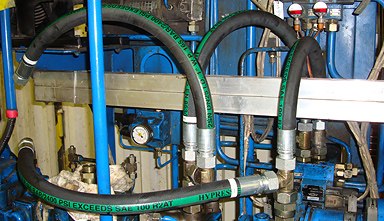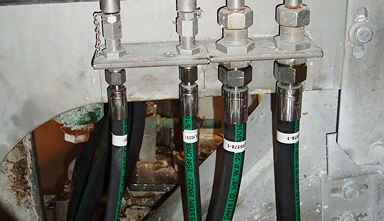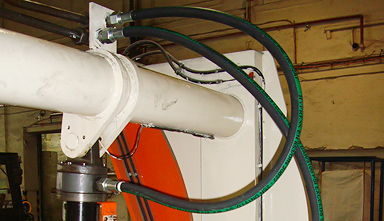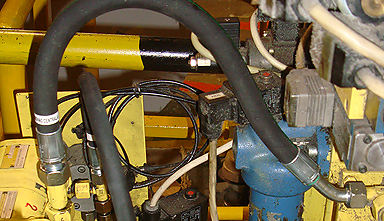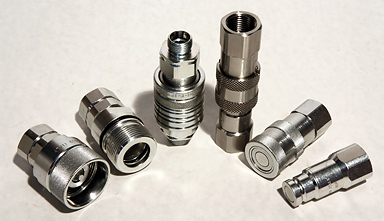Hydraulic hoses
General information Types of hydraulic hoses Fittings for hydraulic hoseData sheet for specification of hoses Catalogue of hydraulic hoses and fittings
General information
Company KOHAFLEX assembles hydraulic hoses, which are intended to transmission of fluid pressure energy. The most used hydraulic hoses are 1SN, 2SN, 2TE, 4SP, 4SH.Hose ends may be used according to international standards, or to manufacture fittings according to special requirement and according to drawing documentation. Fittings could be from galvanized steel (standard hydraulic system applications) or from stainless steel (used in aggressive environments). The company KOHAFLEX also supplies accessories for hydraulic systems such as hydraulic lockshields (DIN2353, SAE, JIC 37°,...) and camlocks from galvanized or stainless steel.
Use of hydraulic hoses
Hydraulic hoses fulfill an important role in the transfer of pressure energy. The main working medium is hydraulic oila, water, water emulsion of mineral and hydraulic oils, fuel (except gasoline), greases or gases. Operating temperature range of transported substance is -40°C up to 100°C at the ambient temperature -40°C up to to 80°C (depending on type of used hose). Pressure resistant of rubber hydraulic hoses is up to 500 bar, the special thermoplastic hoses can be resistant to 2800bar. Based on the working pressure of hydraulic hoses, they can be divided to low-pressure, high pressure аnd hoses designed for extremely high pressures. The most commonly used hydraulic hoses are according to EN853-1SN, 2SN, according to EN856-4SP, 4SH, according to EN857-1SC, 2SC, according to EN854-1TE, 2TE.Material of hydraulic hoses and fittings
At the design of hydraulic hose we must take into consideration use of hose, medium and working parameters (pressure, temperature of medium / ambient temperature). According to used material is possible to divide hydraulic hoses to:- Rubber hydraulic hoses – mostly used in hydraulic systems.
- Thermoplastic hydraulic hoses – based on manufacture flexibility and purity of inner layer they are used in minihydraulic, in measurement and closing systems.
Material of rubber hydraulic hoses:
-
Inner layer – must be designed on basis of transported medium. The most used material is NBR, which is resistant to mineral oils, water, glycol and air. Suitability of use for BIO-oils is necessary to consult with manufacturer, because not all mixture of NBR are suitable for this type of medium. In special cases could be inner sleeve from material VITON or PTFE.
-
Reinforcement – provides resistance of hose against pressure. According to type of hose could be cross-wound (example 1SN, 2SN) or spiral-wound (example 4SH). Reinforcement could be steel or textile, according to type of hose. For suction line of hydraulic circuits i sused hose with steel spiral.
- Outside layer – protects hose against external influences as is heat, abrasion damage, effects of weather. The most used material is NBR, CR or EPDM. In case there is a need for increased resistance to abrasion is possible to use a special material that protects the hose from damage while maintaining the flexibility of the hose.
Material of thermoplastic hydraulic hoses:
-
Inner layer – The most used material for oil-dynamic systems is polyester or polyurethan, which resist to mineral oils, water, glycols and air. Alternatively could be used polyamide suitable for transport of solvents, dyes or gases.
-
Reinforcement – provides resistance of hose against pressure. Material of reinforcement could be steel, textile fiber, polyester fiber or aramide fiber according to type of hose.
- Outside layer – protects hose against external influences ko as is heat, abrasion damage, effects of weather. The most used material is polyuretane. In case of transport of gaseous media can be outer surface microperforated.
Material of fitings and hydraulic threads
For normal hydraulic systems are on hoses pressed fittings from tool steels, which are coated with zinc. Surface finish provides resistance of fittings against corrosion.
In case of transport of aggressive medium or in case of placing hoses in aggressive environments is possible to press on hoses fittings from stainless steel. The most used are AISI 316, AISI 316L or AISI 316Ti.
Hydrauilc threads and couplings is also possible to deliver in material from galvanized steel or for use in aggressive environment from stainless steel.
Protection for hydraulic hoses
In some cases is necessary to protect outside surface by additional protection, for what is possible to use following:- Protection against abrasion – galvanized braiding, stainless steel braiding, steel circular spiral, steel flat spiral, plastic spiral or special outside layer of hose abrasion resistant.
- Protection against heat – sleeve from glass yarns CB30 up to 550°C, protection from ceramic yarns reinforced by glass BB51 up to 700°C, protection from ceramic yarns reinforced by inconel BB52 up to 1100°C, sleeve from glass yarns with silicone PYROTEX, protection sleeve from special yarns TEXIL up to 1200°C
Design of hydraulic hoses
For correct design and aplication of hydraulic hoses is necessary to evaluate following data:- Size of hose DN – inside diameter must be defined so the pressure loss will be minimal and to prevent the hose damage due to generation of heat and turbulence. In case of design a new systems is necessary to choose correct size of hose considering the required flow of medium.
- Temperature – at the hose design have to be taken into account temperature of transported medium and ambient temperature. Temperature has significant impact on lifetime of hose.
- Use – is necessary to define where and how will hose be used. Mentioned facts is necessary to check at each design of hose, also at delivery of hose as a spare parts.
- Material – some applications require to use suitable hose for special oils or chemicals transported in system. Is necessary these requirements to identife for correct design of material of hose, fittings, O-rings and protection.
- Working pressure – pressure in system could not exceed values of allowed working pressure mentioned for individual types of hoses. Also short-time pressure peaks above norm od allowed working pressure significantly reduces life-time of hose and endangers the safety.
- Fittings – is necessary to identify fittings, connection threads and sealing for 100% hose funcionality.
Tests of hydraulic hoses
On request of customer will company KOHAFLEX execute for pressed hoses the following tests:- Pneumatic test for tightness by air overpressure
- Hydraulic test of pressure resistance to 1,5-time of working pressure according to type of hose.
Products of company KOHAFLEX are subjects of continuous monitoring requirements in terms of quality assurance for this type of product. Entry semi-finished products (hose yardage) are periodically tested by destructive, pressure test, the measured data is compared with the requirements of international standards for hydraulic hose.

 English
English Slovensky
Slovensky